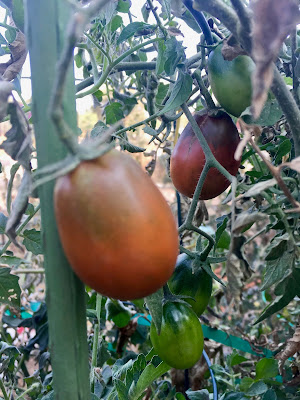Why did that tomato plant come back to life? And other 2018 surprises
 |
Black Plum as of Nov. 10 still had ripening tomatoes.
(Photos: Kathy Morrison)
|
By Kathy Morrison
Since no one is doing much gardening this week, what with the bad air quality and all, I thought I'd look back on the past tomato-growing season and make notes for next year.
The seed catalogs start showing up in December, and nowadays I try to start seeds in late January or early February. I don't want to scare you, but that's just a little over two months away. So here goes:
When you grow two dozen varieties of tomatoes every year, you expect a few surprises.
You hope they're delightful ones, but even the hard lessons are worth it. They inform the next season, which will have its own surprises. That's why I could never be a farmer; the surprises can be costly.
Of the varieties I grew this year, six were new to me: Atlas, Big Mama, Black Plum, Egg Yolk, Sunny Boy and Wild Boar Beauty King. Big Mama was the best of the bunch, a productive red paste tomato that was two to three times the size of normal ones. It's going right into the starting rotation.
Sunny Boy, a golden mid-size tomato, and WB Beauty King, a gorgeous bicolor from heirloom tomato hybridizer Brad Gates, did well enough for me to try again.
Egg Yolk, a yellow-gold cherry, was a complete dud. When the tomatoes looked ripe, they were a bit mushy, unlike the reliable Sun Gold and Sun Sugar types. As the weather got warmer, they stubbornly clung to the vine, splitting at the top when I tugged on them. Who wants to use pruners to pick cherry tomatoes?
Atlas was another dud, and not just in my garden. Master Gardener Gail Pothour of the Fair Oaks Horticulture Center reported it also didn't produce there. In both cases, the plants were in pots, mostly because Atlas was touted as a reliable large red that grew on a compact plant. Nope, not going there again.
Black Plum was the surprise. At the height of summer, with temps daily hitting three digits, I was sure that plant was dead. I had planted it with the others in late April, and it had produced some small brownish/purple plum tomatoes. Nothing exciting, but then most black tomatoes have a reputation for not liking extreme heat. So much for that experiment.
But I didn't take it out in mid-summer because my dependable First Prize plant was all wrapped around it by then, and I was afraid I'd damage the red hybrid if I started chopping.
 |
| These Black Plum tomatoes were harvested in early November. |
So there Black Plum stayed. And the weather gradually cooled, and I kept watering the plants in that segment. They greened up a little, and the spider mites disappeared, and the plants greened up some more. I noticed yellow flowers appearing, then tiny green tomatoes. OK, whatever, I thought.
But then I came back to the garden after a trip near the end of October. Black Plum was covered with gorgeous ripe tomatoes, larger than any it had produced earlier in the year. And two weeks later it still has ripening tomatoes on it.
Note for next year: Black Plum just might be the perfect tomato to grow in Sacramento's fall.
Now, do I start those seeds in February or wait until late spring? Hmm, sounds like another experiment in the making.


Comments
Post a Comment